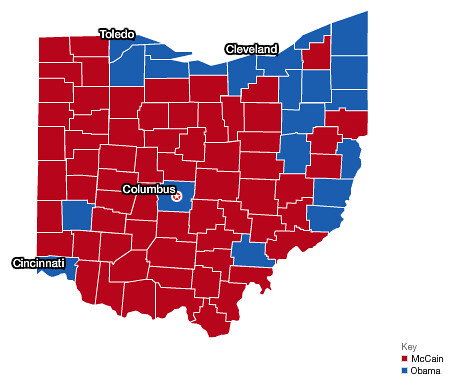ATLANTA – Well, that was unusually inconclusive.
Or was it?
Yes, it was.
1) Mitt Romney has the same rural problem that Barack Obama does. Here’s the map of Ohio from last night’s primary.
 Here’s the map from 2008, an unusually good Democratic year.
Here’s the map from 2008, an unusually good Democratic year.
 Both candidates figured out a pretty simple lesson: Get more votes where people live, don’t lose too many votes where people don’t. But a county map of the primary so far, even if it excludes Missouri, reveals only urban and suburban areas breaking for Romney. The rural areas that build up any eventual nominee’s margin – all for the other guys.
Both candidates figured out a pretty simple lesson: Get more votes where people live, don’t lose too many votes where people don’t. But a county map of the primary so far, even if it excludes Missouri, reveals only urban and suburban areas breaking for Romney. The rural areas that build up any eventual nominee’s margin – all for the other guys.
2) Ron Paul has hit his ceiling. The pre-Tuesday campaign schedule for the Paul campaign pointed reporters to the states where he might win. Idaho’s low-attendence caucus. Alaska’s low-attendence caucus. North Dakota’s low-attendence caucus, where Paul spent election night. In Alaska, where Paul got 2,004 caucus votes in 2008, he drew more than 1,000 to two stump speeches. He had the state to himself. And… he edged up to 3,175 votes, coming in third place.
Yes, the “win”-driven coverage of the primary is a little silly. Paul won delegates in all of yesterday’s caucus states, Vermont, and Virgina. But he’s now averaged around 11 percent of the vote in primaries and 21 percent and caucuses. As he stays in, and as, in April, we move to a winner-take-all process, he’s hitting the natural limits of his support. In Missouri, Santorum could win a one-on-one beauty contest with Romney, with Paul taking votes on the side. In Virginia, Paul could only win 40 percent and one district.
3) Newt Gingrich owns the deep south. He won all but three counties in Georgia, just as he’d won all but three counties in South Carolina. When Florida voted, he won all but three counties in the panhandle, losing two of them (Oskaloosa and Bay) by less than 100 votes. This is one of Mitt Romney’s best prospects for March: Gingrich is in a good position to win Alabama and Mississippi next week, further muddling the “Santorum, conservative champion!” story.
4) Mitt Romney’s a good closer. The frontrunner’s strategy from state to state looks a bit like Galactus’s strategy for planet-devouring: Move in, absorb everything. Restore Our Future is his Silver Surfer, softening up the terrain and warning of doom. So in Tennessee, Romney spent money late, made one appearance, and won voters who decided in the last few days, 30-28 – he lost the state overall, 37-28. In Ohio, where he defeated Rick Santorum by one point, he won last-few-day-voters 43-37. But Santorum had once led by around 10 points in an average of polls. When Romney needs to dispatch Santorum, or he needs to cut into his delegate advantage – as long as Newt Gingrich is in the race, he can do it.
5) Caucuses reveal that the base is cold on Romney. Here are four numbers: 37%, 45%, 60%, 41%. Here are four more: 24%, 32%, 35%, 17%. Those are the numbers for Rommey, respectively, from the 2008 caucuses in North Dakota, Alaska, Colorado, and Minnesota, and from the 2012 caucuses in the same states.
Romney and Galactus: Five Lessons from Super Tuesday

Advertisement